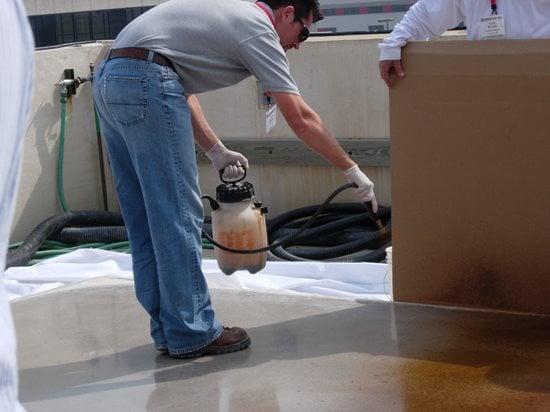- Concrete Stain Home
- Get the Look - Stained Floor Pictures
- Color Chart: Concrete stain colors
- Comparison Chart: Compare acid stains, water-based stains and dyes
- Stain Buying Tips: Questions to ask before you buy
- How to Stain Concrete
- Types of Stains and Coloring Options
- Acid-Based Stains
- Water-Based Penetrating Stains
- Concrete Dyes
- Concrete Paint
- Exterior Concrete Stain: Click through images of outdoor stained concrete projects
- Stains and Equipment Product Reviews
- Troubleshooting Concrete Stains
- Common Staining Issues: Tips from expert Chris Sullivan
- Removing Stains from Concrete
Best Concrete Stains for Indoor & Outdoor Surfaces
Concrete stains are known for their translucent color and one-of-a-kind patterning. Because of concrete's porous qualities, they penetrate and react chemically with the cement, adding permanent color that won't fade, chip, or peel.
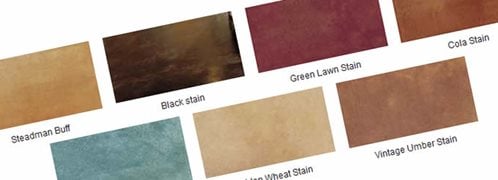 Concrete Stain Color Chart
See samples of popular color choices for staining concrete floors and outdoor surfaces.
Concrete Stain Color Chart
See samples of popular color choices for staining concrete floors and outdoor surfaces.
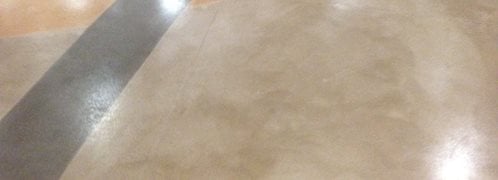 Buy Concrete Stains
Find products for your next project, inlcuding the latest stains and application equipment.
Buy Concrete Stains
Find products for your next project, inlcuding the latest stains and application equipment.
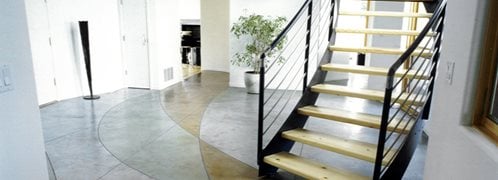 How to Prep Concrete for Stain
Get surface preparation tips from stained concrete pros.
How to Prep Concrete for Stain
Get surface preparation tips from stained concrete pros.
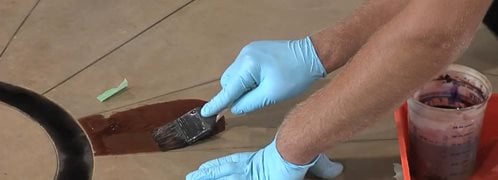 How to Stain Concrete
Get pointers for achieving great results with stains, from surface prep to the final sealer.
How to Stain Concrete
Get pointers for achieving great results with stains, from surface prep to the final sealer.
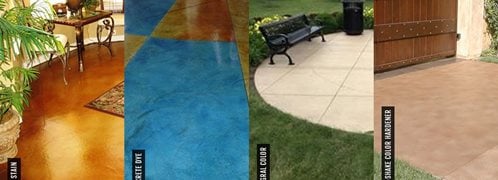 Compare Stain Types
Use this chart to easily compare acid stains, water-based stains, dyes and more.
Compare Stain Types
Use this chart to easily compare acid stains, water-based stains, dyes and more.
 Stained Floor Pictures
View interior stained concrete projects and find out what products were used.
Stained Floor Pictures
View interior stained concrete projects and find out what products were used.
For years, stained concrete contractors have used acid stains to achieve rich, earth-toned color schemes resembling natural stone, marble, wood, or even leather. But today, products such as water-based stains and concrete dyes are expanding the artist's palette with colors ranging from soft pastels to vivid reds, oranges, yellows, and purples. And in some cases, these newer coloring products are easier and safer to apply.
Popular topics on this page:
Outdoor Concrete Stain
Interior Concrete Stain
Concrete Stain vs. Paint & Dye
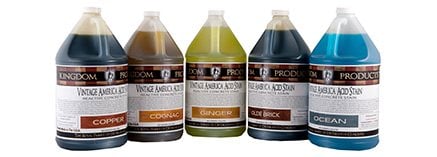 Vintage America Acid Stain
Organic, antique patina, deep penetrating reactive stain.
Vintage America Acid Stain
Organic, antique patina, deep penetrating reactive stain.
 Acid Stain by Surfkoat
Makes up to 2 gallons. Great for marble look.
Acid Stain by Surfkoat
Makes up to 2 gallons. Great for marble look.
 Stain-Crete by Increte
9 standard colors. Useful for old or new concrete.
Stain-Crete by Increte
9 standard colors. Useful for old or new concrete.
 Elements® Transparent Concrete Stain
Water-based, environmentally and user-friendly
Elements® Transparent Concrete Stain
Water-based, environmentally and user-friendly
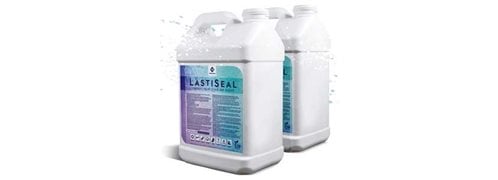 Concrete Stain + Sealer in One
Waterproof, strengthen, preserve and beautify in one step
Concrete Stain + Sealer in One
Waterproof, strengthen, preserve and beautify in one step
 Stone Tone Stain
10 color options. Resistant to chipping and fading.
Stone Tone Stain
10 color options. Resistant to chipping and fading.
 Concrete Acid Stain
BRICKFORM Blush-Tone Acid Stain available in 10 standard colors
Concrete Acid Stain
BRICKFORM Blush-Tone Acid Stain available in 10 standard colors
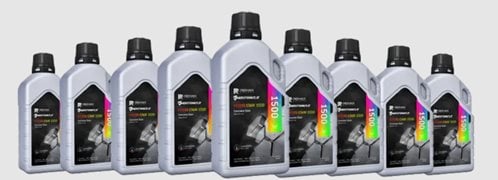 Eco-Friendly, UV-Resistant Stains
15 non-reactive colors that transform concrete.
Eco-Friendly, UV-Resistant Stains
15 non-reactive colors that transform concrete.
BEST OUTDOOR CONCRETE STAIN
Staining is the most affordable and quickest way to transform exterior concrete. In just a couple of days you can take a boring gray slab and transform it into a beautiful stained concrete patio, driveway or pool deck. Typically, acid stains are a more durable choice for exterior concrete stain projects than water-based formulas. However, water-based stains will do fine outside if re-sealed frequently. Ultimately, choosing the best outdoor concrete stain comes down to the desired color and look.
BEST INTERIOR CONCRETE STAIN
Stained concrete floors make beautiful additions to the interiors of homes and businesses alike. When selecting an interior concrete stain keep in mind that acid-based stains are good for high traffic floors due to their longevity, while water-based stains are easier to apply, require less cleanup and aren’t as toxic. Acid stained concrete floors have an old-world mottled look that blends well with stone and wood and helps bring a timeless appeal to your indoor spaces. Concrete floors colored with water-based stains will have more vivid, consistent coloring suitable to more modern interior designs.
CONCRETE STAIN VS. PAINT AND DYE
Stains penetrate the surface of the concrete creating long-lasting color that won’t chip, peel or fade. Commonly available in earth tones, stains impart rich, translucent, variegated color to indoor or outdoor concrete. Imperfections or stains on the concrete often show through, even after multiple coats of stain are applied. Many see this as part of the rustic charm of concrete stains.
Tip: Choose stains if you enjoy a natural look and want something that will last for years.
Concrete paint coats the surface, creating a layer of color that will eventually wear away. Paint is much more susceptible to peeling, chipping and fading. Unlike stains, paint imparts solid and consistent color. Paint can be used indoors or outdoors.
Tip: Choose paint if your concrete is badly stained and you’d like to cover the imperfections.
Concrete dyes offer vibrant color choices such as yellow, blue and purple. They are often used in conjunction with stains to further enhance the final color. Like stains, dyes impart transparent color, but they dry quicker than stains and do not require as much cleanup. Dyes are popular for adding color to polished concrete, but aren’t used often outdoors because they aren’t UV stable.
Tip: Choose dyes if you want vibrant color and are looking for a fast turnaround.
HOW TO STAIN CONCRETE
Whether new or old, concrete of any age can be stained. The concrete staining process will vary depending on the type of stain used, whether it’s being applied indoors or outdoors, and the effect you desire. Always follow the specific instructions provided with the stain you are using.
Generally, there are four important steps when staining concrete:
- Surface preparation
- Application of concrete stain
- Cleanup (and neutralization of acid stains)
- Sealing the concrete
Learning how to stain concrete is easy if you are a professional who’s already familiar with concrete, if you are a DIY homeowner, it will be more challenging, but not impossible. Make sure you thoroughly understand the process before attempting to stain concrete or else you may end up with disappointing results.
CONCRETE STAIN COLORS
The sky is the limit when it comes to concrete stain colors. Acid stains offer a variety of variegated earth tones, while water-based stains offer a broader range of hues, including black, white, yellow and orange. Additionally, many experienced concrete stain applicators will blend colors to create custom shades.
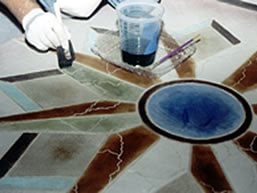
Various colors of stain are applied using small brush to create a detailed design.
Decorative Concrete Institute in Temple, GA
The most popular concrete stain colors are:
- Brown
- Gray
- Tan
- Green
- Terra cotta
- Blue
Many contractors also use sawcuts to create unique patterns on concrete floors or patios that can then be stained multiple colors. The cuts prevent the stains from bleeding into one another and mixing. Stencils made for use on concrete can also be used for creating impressive designs with concrete stains.
CONCRETE ACID STAINS
Acid stains work by chemically reacting with the concrete to change its color and can be used both indoors and outdoors.
Use an acid stain if you want:
- Permanent color that won’t fade, chip or peel
- Rich, natural color variations that bring character and distinction to your concrete
- Deep earth tones that can be diluted to create amazing effects
Concrete Acid Stains & Coloring Options
Time: 03:58
The primary benefit of acid stains is that once the reaction is complete the color is permanent and won't fade, chip off, or peel away. Acid stains are translucent and produce a unique look every time depending on the condition of the concrete. The colors are limited primarily to earth tones and the acid in the stain must be neutralized to stop the reaction.
Tips for applying an acid stain to concrete:
- Do not acid-wash before application
- Wear protective gear and be cautious when working with acids
- Allow acid stains to dry for 5-24 hours, depending on the intensity of color desired
- Neutralize acid stains with alkaline soap and water
Learn more: Tips for Choosing the Right Stain for Your Project
WATER-BASED CONCRETE STAINS
Water-based concrete stains are a newer, non-reactive option for staining concrete. Like acid stains they are UV stable and can be used indoors and outdoors, but unlike acid stains they offer a full spectrum of colors with longer working times.
Use water-based stains if:
- Your project calls for colors not available with acid stains
- You want to be able to create artistic effects by blending or layering colors
- You want a stain that’s safe and easy to apply
Additionally, water-based stains impart a more consistent color (as opposed to the strong variegation of acids stains). Many staining pros like using water-based stains because they are safer to apply, have faster drying times, are low in VOCs, and save time and labor. Most non-reactive stains call for acid washing to open and prepare the concrete surface to ensure good adhesion.
Water-based concrete stains come in the following options:
- Solid color
- Semi-transparent
- Acrylic
SPECIALTY STAINS
Stain manufacturers are always looking to improve their products. As a result, you can find a variety of specialty stains, including:
- Stain and sealer combos
- Antiquing stains
- Gelled stains
- Stains for recoloring
- Polychromatic stains
HOMEMADE CONCRETE STAINS
Whether you're looking to save money or avoid toxins, you may be wondering how to make your own concrete stain. We've seen concrete stained with any of the following:
- Coffee
- Fabric dye
- Iron sulfate
- Copper sulfate
- Beer or wine
But keep in mind, that the results are more consistent when using a professionally developed product like those featured here.
CONCRETE STAIN REVIEWS
The concrete stains with the best reviews tend to be professional grade, not the type you can buy at your local hardware store. Professional grade stains can be ordered online through specialized companies, or purchased at your local concrete supply store.
Top reasons for a good concrete stain review:
- Easy to apply
- Dries evenly
- Adheres well
- Fast return to service
- Rich, dark color
- Can be diluted for color control
- Doesn’t fade
- Works well on new or old concrete
- Ages nicely
CAN NEW CONCRETE BE STAINED?
New concrete can be stained after it has had time to fully cure. This will vary depending on the circumstances, but average curing time is 28 days. Warmer temperatures and stiffer concrete mix can lead to faster cure times, while cooler temperatures and a wetter mix can delay the process. Some stain manufacturers suggest waiting until the concrete is all one uniform color.
Here are tips for pouring and finishing new concrete that will be stained:
- Do not finish the concrete in a way that closes up the surface
- Do not use curing compounds, they will prevent the stain from penetrating
- Protect the concrete while it cures and make sure other trades know it will be the finished floor
- Ensure that the concrete is left in its natural state without any sealers, waxes or coatings
- Do not acid etch the concrete, this will prevent the stain from bonding
CONCRETE STAINING TIPS
Knowing some tricks of the trade is always helpful when starting a concrete staining project. Make sure to read the instructions that come with the stain you are using before getting started.
When staining concrete consider the following:
- Make sure the concrete is fully cured before applying concrete stains
- Concrete can be re-stained as long as it hasn’t been sealed (or the sealer has been removed)
- Once you know how they work acid and water-based stains can be used on the same project
- Make samples or test in a discreet area before applying concrete stain to the entire surface
- Always seal stained concrete, whether indoors or out, acid or water-based
Find contractors that offer concrete staining near me.
CAN CONCRETE BE RESTAINED?
If you are unhappy with the color of your stained concrete or you’d like to refresh concrete that was stained long ago, there are a few options. Water-based stains or dyes are great for restoring color to faded concrete. Before restaining it is essential to make sure any remaining sealer has been removed so that the stain can properly bond with the concrete.
In general, making a stain color darker can be done easily, but lightening the color is a different story. For this reason many contractors apply multiple layers of diluted stain until they reach the desired color. In the case of stain that came out too dark, you can start fresh with an overlay or try to pull the color back out of the concrete with an acidic solution. Yet another option for changing the color of stained concrete is a tinted sealer.
HOW MUCH STAIN DO I NEED?
To determine how much stain you need for your project you will need to know the following:
- The coverage rate of the specific stain you plan to use
- How many square feet of concrete you will be staining
- How many coats of stain you will be applying
Coverage rates are available from stain manufacturers and usually presented in square feet per gallon. The age and condition of the concrete will impact the coverage rate. More porous concrete will result in a lower coverage rate and thus more stain will be required.
On average, acid stains will cover 200 to 400 square feet per gallon, while water based stains will cover slightly more at about 250 to 450 square feet per gallon. Both acid based and water based stains can be diluted to get more coverage, however this will also lessen the intensity of the color.
Here’s an example of how to calculate how much stain you will need:
- Coverage rate minimum is 200 square feet per gallon
- The patio measures 300 square feet
- Divide the square footage by the coverage rate
- You will need 1.5 gallons of stain
If you plan to apply multiple coats of stain you will need even more. Often the stain will have a better coverage rate on subsequent coats, which means you will need less.
HOW LONG DOES IT TAKE FOR CONCRETE STAIN TO DRY?
Acid stain will be dry to the touch in 15-20 minutes, but that doesn’t mean the reaction is complete. Most stain manufacturers recommended a dry time of up to 24 hours. Many contractors find that letting stain dry overnight is sufficient and convenient for their schedule. If applying multiple coats of stain, allow for an hour or two of dry time in between.
Drying times for stains will vary based on:
- Concrete and air temperature
- Humidity
- Concrete porosity
After the stain has dried the acid needs to be rinsed and neutralized. Then there will be a few more hours of waiting for the concrete to dry before applying a sealer. The concrete must be completely dry and free of residue for the sealer to bond well. After the sealer is applied, you should wait at least 24 hours before returning to using the concrete as normal. Overall, the staining and sealing process should take 2 to 3 days.
Water based stains dry faster than acid stains and do not require neutralization before sealing. This makes them a great option for fast-track projects.
Free report:
Concrete Staining Today
